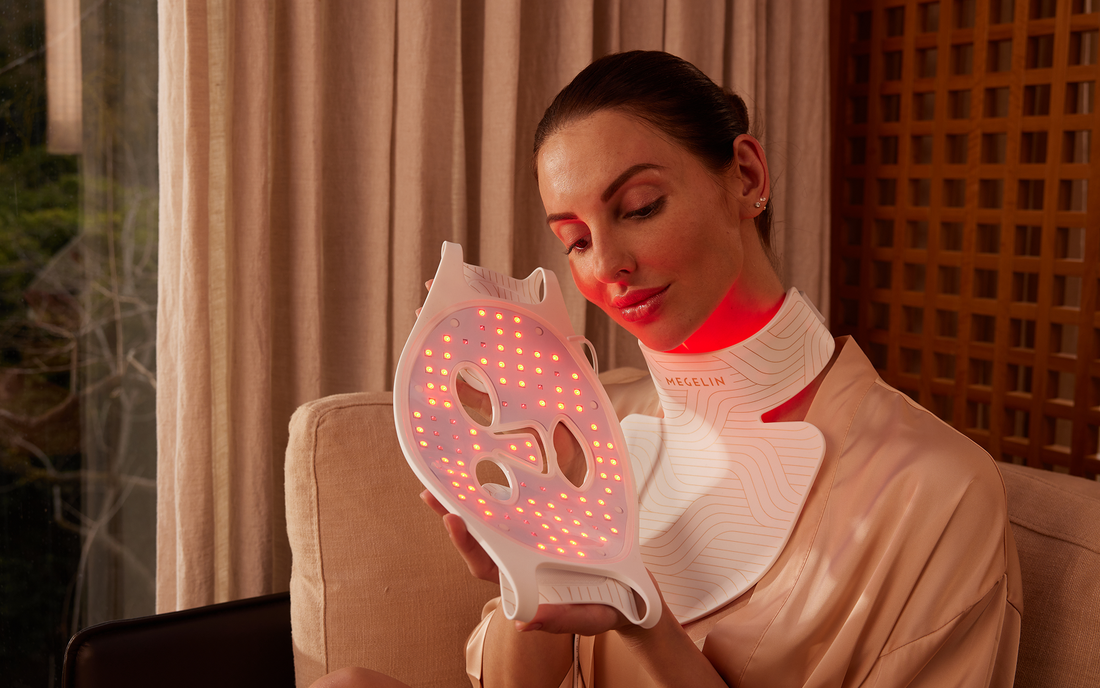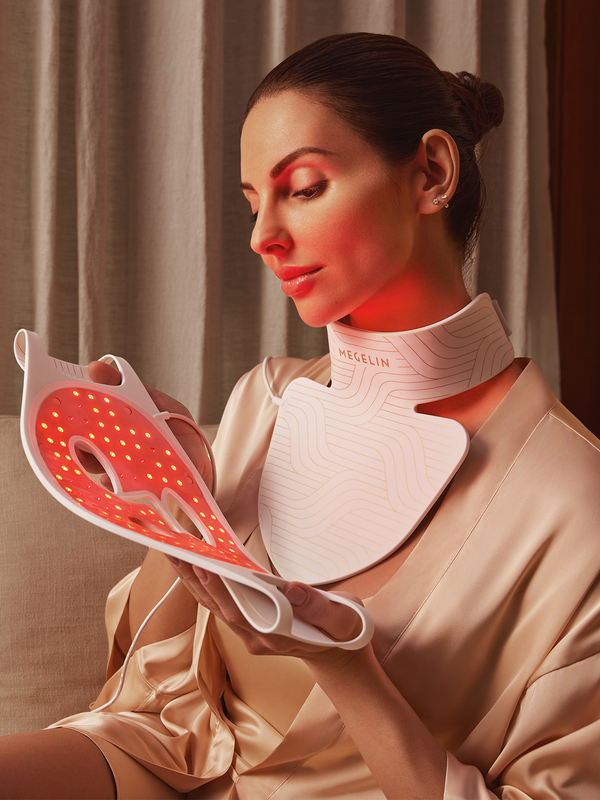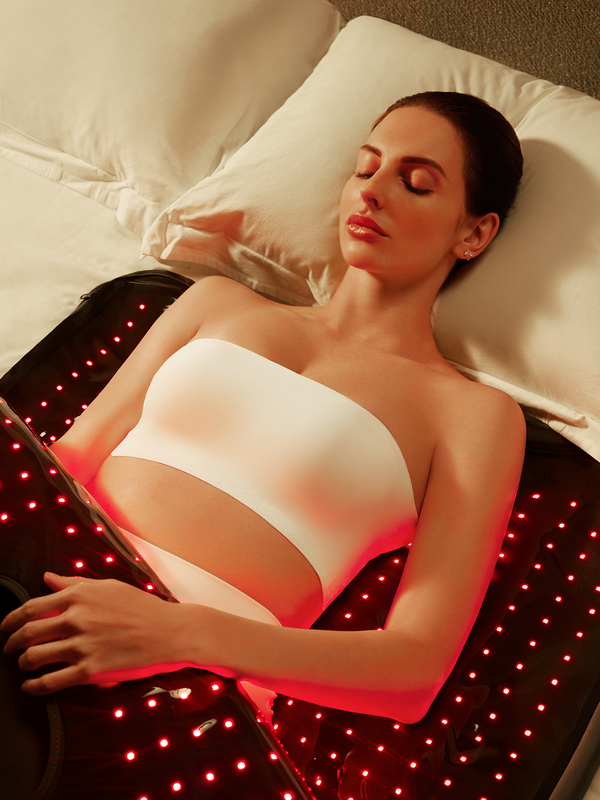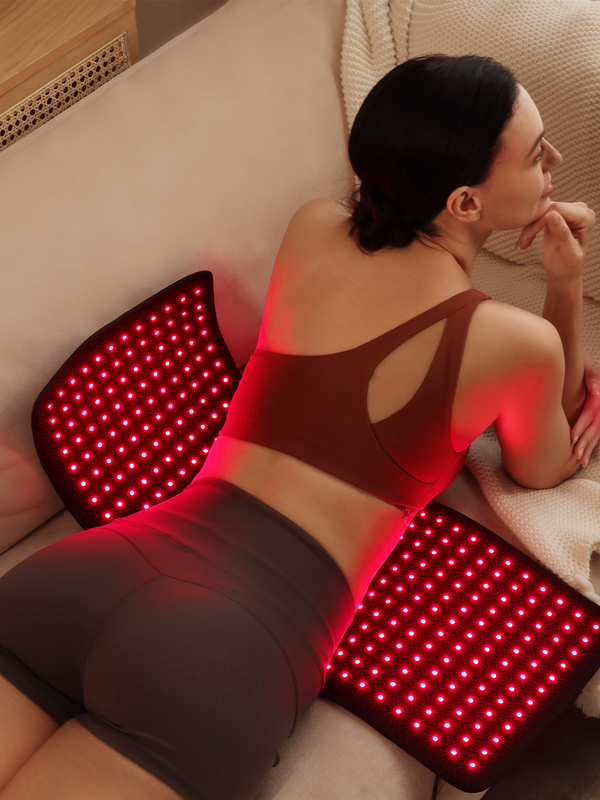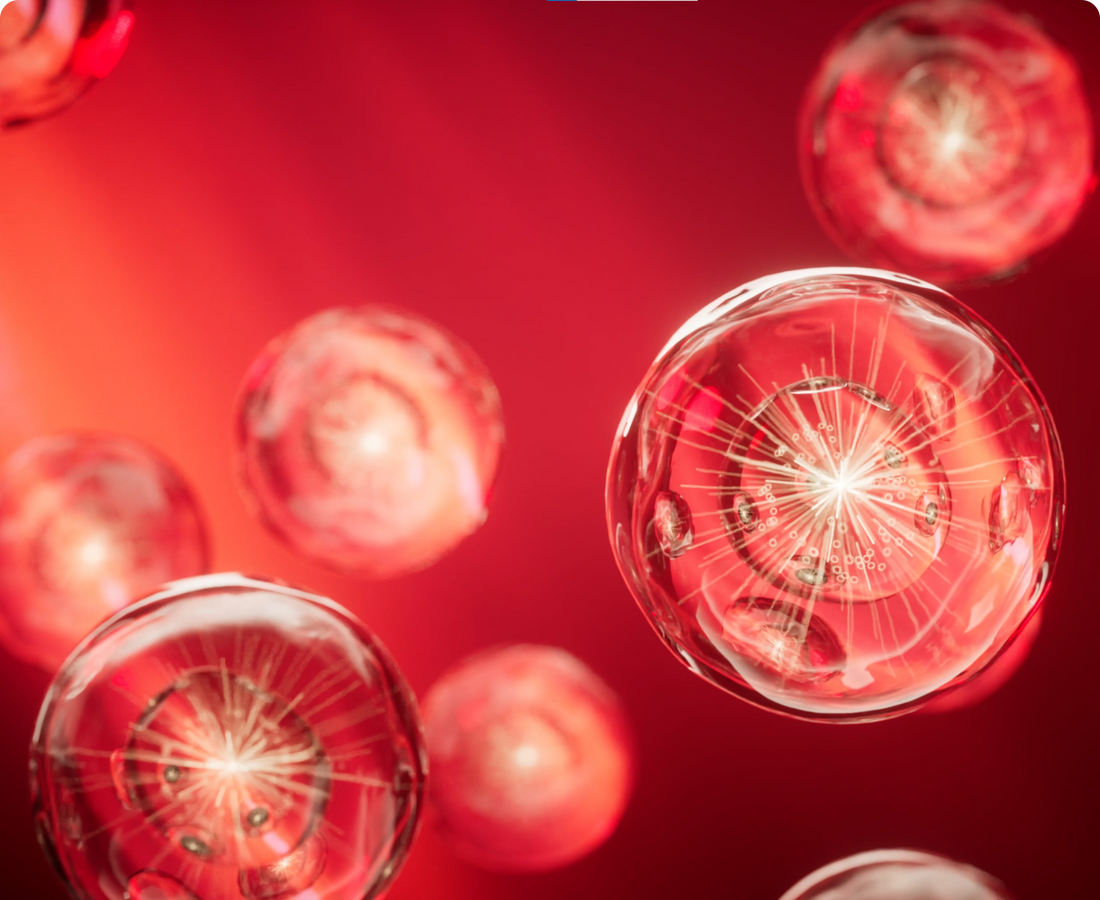
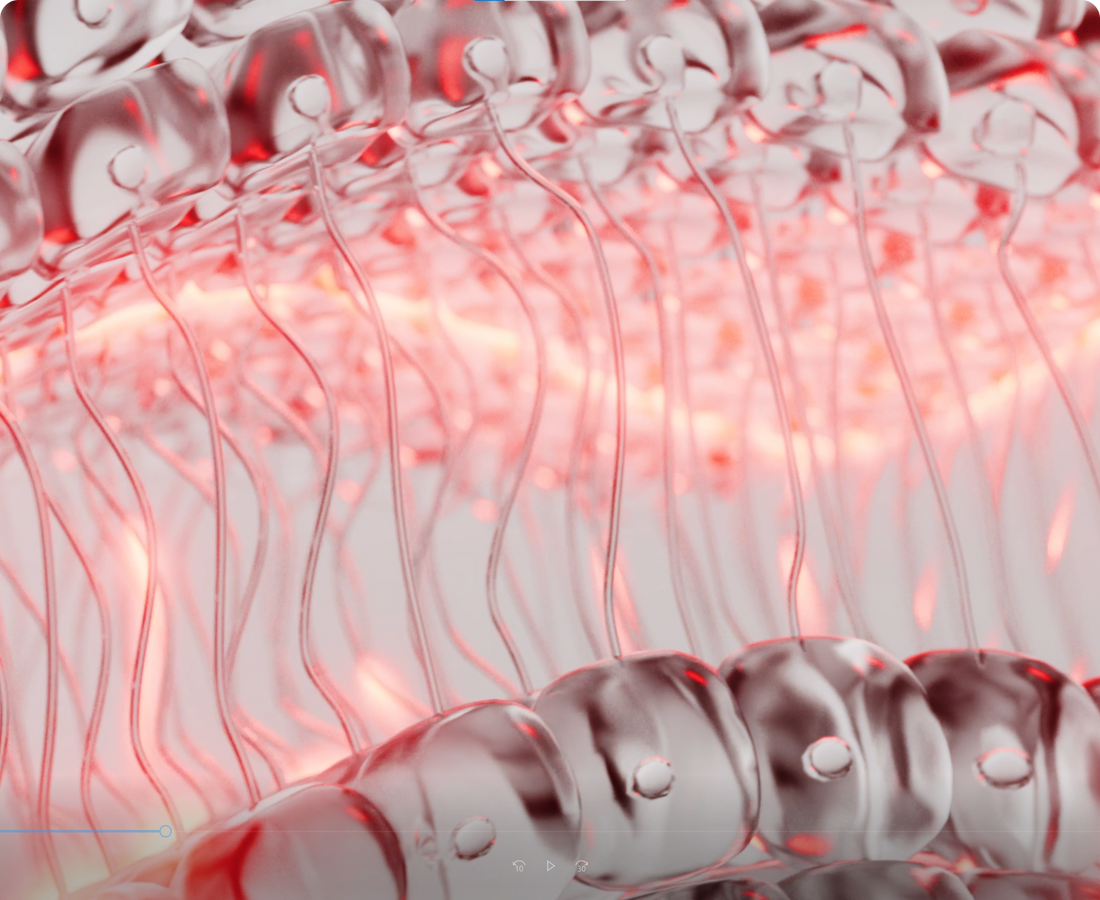
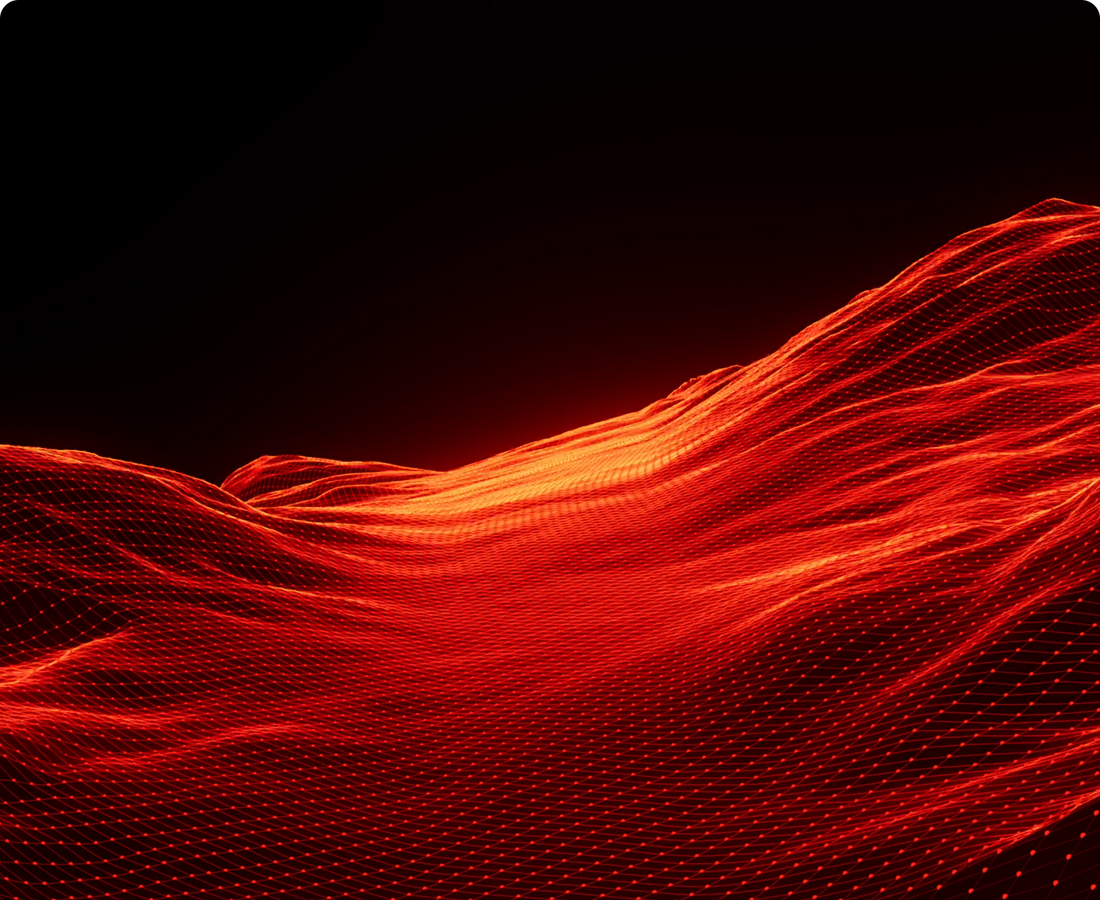
Blue light has been clinically proven to work on the skin’s surface, delivering the following benefits:
- Fights acne-causing bacteria
- Balances oil production
- Calms inflammation
Clinically, blue light therapy tackles acne naturally by targeting its root causes. It destroys acne-causing bacteria by activating their natural porphyrins, creating oxygen-free radicals that eliminate breakouts without chemicals. Simultaneously, it calms inflammation and reduces redness while regulating oil production to prevent future clogged pores. For enhanced results, pairing blue light with red light accelerates healing and soothes skin further —offering a safe, non-invasive solution for clearer, healthier skin.
1. Phototherapy with blue (415 nm) and red (660 nm) light in the treatment of acne vulgaris
Papageorgiou P, Katsambas A, Chu A.
Br J Dermatol. 2000; 142(5): 973–978.
2. Eradication of Propionibacterium acnes by its endogenic porphyrins after illumination with high-intensity blue light
Ashkenazi H, Malik Z, Harth Y, Nitzan Y.
FEMS Immunol Med Microbiol. 2003 Jan 21; 35(1): 17–24.
3. The clinical and histological effect of home-use, combination blue-red LED phototherapy for mild-to-moderate acne vulgaris in Korean patients: a double-blind, randomized controlled trial
Kwon HH, Lee JB, Yoon JY, Park SY, Ryu HH, Park BM, Kim JY, Lee JH, Park SY, Park KC, Suh DH.
Br J Dermatol. 2013; 168(5): 1088–1094.
Clinical studies on green light are limited, but existing research highlights its potential benefits:
- Reduce appearance of dark spots
- Calms skin redness
- Relieves head pain
Green light therapy is a clinically studied, non-invasive treatment that improves skin tone by selectively targeting melanin and hemoglobin— reducing hyperpigmentation, redness, and visible blood vessels. Evidence suggests it also exerts anti-inflammatory effects and may stimulate endogenous pain-relief pathways, offering potential therapeutic benefits. While red light remains the most established for hair regrowth, preliminary research indicates green light may enhance outcomes when combined.
1.VISIA Skin Analysis System as a Tool to Evaluate the Reduction of Pigmented Skin and Vascular Lesions Using the 532 Nm Laser
Zawodny P, Stój E, Kulig P, Skonieczna-Żydecka K, Sieńko J.
Clin Cosmet Investig Dermatol. 2022 Oct 14; 15: 2187–2195.
2.Looking for a Beam of Light to Heal Chronic Pain
Xu J, Zhang H, Chen D, Xu K, Li Z, Wu H, Geng X, Wei X, Wu J, Cui W, Wei S.
J Pain Res. 2024 Mar 16; 17: 1091–1105.
3.Green Light Exposure Elicits Anti-inflammation, Endogenous Opioid Release, and Dampens Synaptic Potentiation to Relieve Post-surgical Pain
Martin LF, Cheng K, Washington SM, Denton M, Goel V, Khandekar M, Patwardhan A, Ibrahim MM.
J Pain. 2023 Mar; 24(3): 509–529.
4.Low-level Green Laser Promotes Wound Healing After Carbon Dioxide Fractional Laser Therapy
Gong C, Lu Y, Jia C, Xu N.
J Cosmet Dermatol. 2022 Nov; 21(11): 5696–5703.
Like green light, clinical research on yellow light is limited. However, existing studies highlight its benefits:
- Reduces redness
- Inhibits melanin production & angiogenesis
- Reduces the appearance of spots
Yellow LED light therapy—a gentle yet potent solution for a brighter, more even complexion. Clinically proven to inhibit melanin production at its source, this treatment disrupts excess pigment synthesis and fades stubborn dark spots, melasma, and post-acne marks—even on sensitive skin—by suppressing overactive melanocytes for a more balanced tone. For enhanced results, combining yellow light with complementary wavelengths can further optimize skin rejuvenation.
1.Light-emitting diode 585nm photomodulation inhibiting melanin synthesis and inducing autophagy in human melanocytes
Li Chen, Zhongyi Xu, Min Jiang, Chengfeng Zhang, Xuan Wang, Leihong Xiang.
J Dermatol Sci. 2018 Jan; 89(1): 11-18.
2.585 nm light-emitting diodes inhibit melanogenesis through upregulating H19/miR-675 axis in LEDs-irradiated keratinocytes by paracrine effect
Shanglin Jin, Li Chen, Zhongyi Xu, Xiaoxue Xing, Chengfeng Zhang, Leihong Xiang.
J Dermatol Sci. 2020 May; 98(2): 102-108.
3.590 nm LED Irradiation Improved Erythema through Inhibiting Angiogenesis of Human Microvascular Endothelial Cells and Ameliorated Pigmentation in Melasma
Xiaoxi Dai, Shanglin Jin, Yijie Xuan, Yiwen Yang, Xiaoli Lu, Chen Wang, Li Chen, Leihong Xiang, Chengfeng Zhang.
Cells. 2022 Dec 7; 11(24): 3949.
Extensive research confirms the benefits of red light for both skin and overall health, including:
- Stimulates collagen and elastin
- Smooths fine lines
- Calms inflammation
Research shows that red light photobiomodulation energizes mitochondria, boosting ATP production, reducing damage, and promoting cellular repair in skin, hair, and wound healing. It increases collagen density, smoothing fine lines, wrinkles, and skin roughness. This gentle yet powerful treatment enhances skin renewal, improving tone and restoring a healthy glow—all with zero downtime.
1.Low-level laser (light) therapy (LLLT) in skin: stimulating, healing, restoring
Avci P, Gupta A, Sadasivam M, Vecchio D, Pam Z, Pam N, Hamblin MR.
Semin Cutan Med Surg. 2013; 32(1): 41-52.
2.A controlled trial to determine the efficacy of red and near-infrared light treatment in patient satisfaction, reduction of fine lines, wrinkles, skin roughness, and intradermal collagen density increase
Wunsch A, Matuschka K.
Photomed Laser Surg. 2014; 32(2): 93-100.
3.Mechanisms and applications of the anti-inflammatory effects of photobiomodulation
Hamblin MR.
Near-infrared light (830–880 nm) penetrates deeper into the skin than red light, reaching the dermis and tissues. It stimulates mitochondria, boosting collagen production for firmer skin, activating hair follicles for thicker growth, and reducing inflammation for faster healing. Additionally, it supports bone repair. Compared to red light, which primarily targets surface layers, near-infrared light provides deeper therapeutic benefits, promoting skin rejuvenation and overall tissue healing.
1.Noninvasive red and near-infrared wavelength-induced photobiomodulation: promoting impaired cutaneous wound healing.
Anju Yadav, Asheesh Gupta.
Photodermatol Photoimmunol Photomed. 2017 Jan; 33(1): 4-13
2.NIR light-assisted phototherapies for bone-related diseases and bone tissue regeneration: A systematic review
Zhuqing Wan, Ping Zhang, Longwei Lv, Yongsheng Zhou.
Theranostics. 2020 Sep 26; 10(25): 11837-11861.
NIR light at 1064 nm penetrates deep into the dermis and subcutaneous layers, making it ideal for non-ablative skin rejuvenation, scar revision, and anti-inflammatory treatments. It stimulates collagen renewal and elastin production, reducing wrinkles, tightening skin, and repairing sun damage. Compared to 850 nm, which targets more superficial tissues, 1064 nm reaches deeper layers, making it more effective for treating deep wrinkles, scars, and chronic inflammation. Its anti-inflammatory properties help reduce redness and rosacea, with minimal risk of pigmentation issues, making it suitable for all skin types.
1.Objective assessment of skin rejuvenation using near-infrared 1064-nm neodymium: YAG laser in Asians
Yohei Tanaka 1, Kiyoshi Matsuo, Shunsuke Yuzuriha.
Clin Cosmet Investig Dermatol. 2011: 4: 123-30.
2.Long-pulsed 1064-nm Nd: YAG laser ameliorates LL-37-induced rosacea-like skin lesions through promoting collagen remodeling in BALB/c mice
Miri Kim 1, Jongsic Kim 1, Seo-Won Jeong 1, Hyunmu Jo 1, Hyun Jeong Park 2.
Lasers Med Sci. 2018 Feb; 33(2): 393-397.
3.Combination 532-nm and 1064-nm lasers for noninvasive skin rejuvenation and toning
Min-Wei Christine Lee 1.
Arch Dermatol. 2003 Oct; 139(10): 1265-76.
Traditional skincare primarily works on the surface, while light therapy penetrates deep into the skin, activating cellular vitality at the source.
Through photobiomodulation, light therapy stimulates collagen production—essential for skin firmness and elasticity—helping to reduce wrinkles caused by sagging. It also enhances cellular energy, accelerates metabolism, and repairs aging tissue, naturally smoothing fine lines.
Additionally, light therapy improves nutrient absorption and strengthens the skin’s defense against environmental damage, restoring a youthful glow. Despite daily light exposure, the skin still responds effectively to targeted wavelengths like red and near-infrared light.
1.Low-level laser (light) therapy (LLLT) in skin: stimulating, healing, restoring
Avci P, Gupta A, Sadasivam M, Vecchio D, Pam Z, Pam N, Hamblin MR.
Semin Cutan Med Surg. 2013 Mar; 32(1): 41-52.
2.A prospective, randomized, placebo-controlled, double-blinded, and split-face clinical study on LED phototherapy for skin rejuvenation: clinical, profilometric, histologic, ultrastructural, and biochemical evaluations and comparison of three different treatment settings
Lee S Y, Park K H, Choi J W, et al.
Journal of photochemistry and photobiology B: Biology, 2007, 88(1): 51-67.
3.The Efficacy and Safety of 660 nm and 411 to 777 nm Light-Emitting Devices for Treating Wrinkles
Nam CH, Park BC, Kim MH, Choi EH, Hong SP.
Dermatol Surg. 2017 Mar; 43(3): 371-380.
4.Reverse skin aging signs by red light photobiomodulation
Couturaud V, Le Fur M, Pelletier M, Granotier F.
Skin Res Technol. 2023 Jul; 29(7): e13391.
5.Male facial rejuvenation using a combination 633, 830, and 1072 nm LED face mask
Mineroff J, Austin E, Feit E, Ho A, Lowe B, Marson J, Mojeski J, Wechter T, Nguyen JK, Jagdeo J.
Arch Dermatol Res. 2023 Nov; 315(9): 2605-2611.
6.A controlled trial to determine the efficacy of red and near-infrared light treatment in patient satisfaction, reduction of fine lines, wrinkles, skin roughness, and intradermal collagen density increase
Wunsch A, Matuschka K.
Photomed Laser Surg. 2014 Feb; 32(2): 93-100.
Acne results from excess oil production, clogged pores, and bacterial infection. While antibiotics are a common treatment, their widespread use has led to antibiotic resistance. Light therapy offers a non-invasive alternative, effectively targeting acne with blue and red wavelengths.
Blue light eliminates acne-causing bacteria, reducing inflammation at the source. Red light penetrates deeper, promoting skin repair, calming redness, and regulating the skin’s immune response. Unlike topical or oral treatments, light therapy is non-irritating, free of side effects, and safe for most skin types, including sensitive skin.
1.Blue and red light combination LED phototherapy for acne vulgaris in patients with skin phototype
IVLee SY, You CE, Park MY.
Lasers Surg Med. 2007 Feb; 39(2): 180-8.
2.Effect of Blue Light on Acne Vulgaris: A Systematic Review
Diogo MLG, Campos TM, Fonseca ESR, Pavani C, Horliana ACRT, Fernandes KPS, Bussadori SK, Fantin FGMM, Leite DPV, Yamamoto ÂTA, Navarro RS, Motta LJ.
Sensors (Basel). 2021 Oct 19; 21(20): 6943.
3.Randomized trial of three phototherapy methods for the treatment of acne vulgaris in Chinese patients
Liu LH, Fan X, An YX, Zhang J, Wang CM, Yang RY.
Photodermatol Photoimmunol Photomed. 2014 Oct; 30(5): 246-53.
4.Photobiomodulation: The Clinical Applications of Low-Level Light Therapy
Glass GE
Aesthet Surg J. 2021 May 18; 41(6): 723-738.
5.Blue-Light Therapy for Acne Vulgaris: A Systematic Review and Meta-Analysis.
Ann Fam MedScott AM, Stehlik P, Clark J, Zhang D, Yang Z, Hoffmann T, Mar CD, Glasziou P.
Ann Fam Med. 2019 Nov; 17(6): 545-553.
Wound healing involves inflammation control, cell proliferation, and tissue remodeling. Light therapy accelerates this process by energizing cells, stimulating blood vessel formation, and improving circulation, ensuring oxygen and nutrients reach the damaged area for faster recovery.
Additionally, light therapy promotes collagen production, which is crucial for wound repair. Collagen strengthens the skin, enhances its toughness, and reduces scar formation. For a natural and effective solution to wound healing, light therapy is a proven, trusted option.
1.Effects of low-power light therapy on wound healing: LASER x LED
Chaves MEDA, Araújo A R, Piancastelli A C C, et al.
Anais brasileiros de dermatologia, 2014, 89(4): 616-623.
2.Wound Phototherapy
Bolton LL.
Wounds. 2020 Sep; 32(9): 262-264.
3.Photobiomodulation: The Clinical Applications of Low-Level Light Therapy
Glass GE.
Aesthet Surg J. 2021 May 18; 41(6): 723-738.
4.Red light-emitting diode (LED) therapy accelerates wound healing post-blepharoplasty and periocular laser ablative resurfacing
Trelles MA, Allones I.
J Cosmet Laser Ther. 2006 Apr; 8(1): 39-42.
5.The effect of combined red, blue, and near-infrared light-emitting diode (LED) photobiomodulation therapy on speed of wound healing after superficial ablative fractional resurfacing
Soliman J, Elsanadi R, Messele F, Kelly KM.
Lasers Med Sci. 2024 Mar 27; 39(1): 94.
6.Merged Red and NIR Light Sources for Photobiomodulation Therapy in Diabetic Wound Healing
Thien Tri T, Nam ND, Lee TH, Shin H, Lee HJ, Chae H, Kim MJ, Jo DS, Cho SM.
ACS Appl Mater Interfaces. 2025 Jan 29; 17(4): 5771-5783.
Inflammation is a natural defense against infection, injury, or irritation, but when excessive or prolonged, it can lead to chronic pain, tissue damage, and accelerated aging.
Light therapy inhibits inflammation through multiple mechanisms: it reduces the release of pro-inflammatory factors, lowers cellular sensitivity to inflammatory stimuli, and helps clear harmful byproducts. This promotes a balanced healing process.
Since inflammation often stems from immune system imbalances, light therapy also regulates immune cell activity, preventing excessive or chronic inflammation. Its ability to restore immune balance makes it effective for both acute and long-term inflammatory conditions, providing a non-invasive, science-backed approach to healing and relief.
1.Mechanisms and applications of the anti-inflammatory effects of photobiomodulation.
Hamblin MR.
AIMS Biophys. 2017; 4(3): 337-361.
2.Infrared light therapy relieves TLR-4 dependent hyper-inflammation of the type induced by COVID-19.
Aguida B, Pooam M, Ahmad M, Jourdan N.
Commun Integr Biol. 2021 Sep 15; 14(1): 200-211.
3.Laser Light Therapy in Inflammatory, Musculoskeletal, and Autoimmune Disease.
Wickenheisser VA, Zywot EM, Rabjohns EM, Lee HH, Lawrence DS, Tarrant TK.
Curr Allergy Asthma Rep. 2019 Jul 2; 19(8): 37.
4.Low level laser therapy: molecular mechanisms of anti-inflammatory and regenerative effects
Greben AI, Eremin PS, Kostromina EY, Markov PA, Greben TN, Gilmutdinova IR, Konchugova TV.
Vopr Kurortol Fizioter Lech Fiz Kult. 2023; 100(2): 61-68.
5.The effect of red-to-near-infrared (R/NIR) irradiation on inflammatory processes
Walski T, Dąbrowska K, Drohomirecka A, Jędruchniewicz N, Trochanowska-Pauk N, Witkiewicz W, Komorowska M.
Int J Radiat Biol. 2019 Sep; 95(9): 1326-1336.
Hyperpigmentation—such as melasma, acne marks, and sunspots—occurs due to melanin buildup, metabolic imbalances, and poor circulation. When melanocytes overproduce pigment under oxidative stress, the skin struggles to maintain an even tone.
Tyrosinase, a key enzyme in melanin production, plays a central role in pigmentation. Light therapy intervenes directly in this process: blue light disrupts melanocyte activity and inhibits tyrosinase, reducing melanin synthesis. Red light, by enhancing mitochondrial function, regulates melanocyte metabolism and prevents excessive pigment production.
Beyond slowing melanin formation, certain wavelengths activate the skin’s autophagy process, helping cells clear excess pigment more efficiently. This accelerates the fading of dark spots and discoloration.
1.A prospective randomized comparative study on 60 Indian patients of melasma, comparing pixel Q-switched NdYAG (1064 nm), super skin rejuvenation (540 nm) and ablative pixel erbium YAG (2940 nm) lasers, with a review of the literature
Garg S, Vashisht KR, Makadia S.
Cosmet Laser Ther. 2019 Aug; 21(5): 297-307.
2.Laser therapy in the treatment of melasma: a systematic review and meta-analysis
Lai D, Zhou S, Cheng S, Liu H, Cui Y.
Lasers Med Sci. 2022 Jun; 37(4): 2099-2110.
3.590 nm LED Irradiation Improved Erythema through Inhibiting Angiogenesis of Human Microvascular Endothelial Cells and Ameliorated Pigmentation in Melasma
Dai X, Jin S, Xuan Y, Yang Y, Lu X, Wang C, Chen L, Xiang L, Zhang C.
Cells. 2022 Dec 7; 11(24): 3949.
4.Light-emitting diode 585 nm photomodulation inhibiting melanin synthesis and inducing autophagy in human melanocytes
Chen L, Xu Z, Jiang M, et al.
J Dermatol Sci. 2018 Jan; 89(1): 11-18.
5.Inhibitory effect of 660-nm LED on melanin synthesis in in vitro and in vivo
Oh CT, Kwon TR, Choi EJ, Kim SR, Seok J, Mun SK, Yoo KH, Choi YS, Choi SY, Kim BJ.
Photodermatol Photoimmunol Photomed. 2017 Jan; 33(1): 49-57.
Pain is a common symptom of various health issues and a leading cause of medical visits. While traditional treatments like medications and nerve blocks have limitations, light therapy offers a proven, non-invasive, and affordable alternative with minimal side effects and high safety.
Light therapy alleviates pain by modulating neurotransmitter release, reducing pain signals, and lowering brain excitability. It also promotes the release of pain-relieving substances, offering mild but lasting relief. Furthermore, light therapy improves blood circulation, delivering oxygen and nutrients more efficiently to the affected area, accelerating waste removal, and reducing inflammation-related pain.
This makes light therapy effective not only for acute injuries, such as sports-related or post-surgical pain, but also for chronic pain in joints and nerves. As a sustainable, healthy form of pain management, light therapy helps restore the body to its optimal state.
1.Low-intensity LASER and LED (photobiomodulation therapy) for pain control of the most common musculoskeletal conditions
DE Oliveira MF, Johnson DS, Demchak T, Tomazoni SS, Leal-Junior EC.
Eur J Phys Rehabil Med. 2022 Apr; 58(2): 282-289.
2.Low-Level Laser Therapy for Fibromyalgia: A Systematic Review and Meta-Analysis
Yeh SW, Hong CH, Shih MC, Tam KW, Huang YH, Kuan YC.
Pain Physician. 2019 May; 22(3): 241-254.
3.Light-emitting diode phototherapy: pain relief and underlying mechanisms
Zhang WW, Wang XY, Chu YX, Wang YQ.
Lasers Med Sci. 2022 Jul; 37(5): 2343-2352.
4.The efficacy of low-level laser therapy for shoulder tendinopathy: a systematic review and meta-analysis of randomized controlled trials
Haslerud S, Magnussen LH, Joensen J, Lopes-Martins RA, Bjordal JM.
Physiother Res Int. 2015 Jun; 20(2): 108-25.
5.The associations between diode laser (810 nm) therapy and chronic wound healing and pain relief: Light into the chronic wound patient's life
Tang D, Liu C, Chen X, Lv X, Yuan L, Xue D, Song H.
Wound Repair Regen. 2023 Mar; 31(2): 227-232.
For effective health management and body shaping, exercise and diet are fundamental. As a non-invasive approach, light therapy enhances fat metabolism at the cellular level, promoting more efficient fat breakdown and scientifically supported body contouring.
Fat accumulation plays a key role in body shape changes. Light therapy utilizes specific wavelengths to target fat cells, increasing membrane permeability to facilitate fat release and metabolism. As lipids break down, fat cells shrink, leading to gradual fat reduction without the need for heat-based or invasive procedures, making it a safe complement to traditional weight management strategies.
Metabolism is a critical factor in fat loss, directly influencing fat breakdown efficiency. Light therapy stimulates mitochondrial activity, boosting cellular energy production and enhancing the body’s ability to burn calories even at rest.
While light therapy offers a scientifically supported and gentle approach to body contouring, its effectiveness is maximized when combined with regular exercise and a balanced diet.
1.Low‐level laser therapy for fat layer reduction: a comprehensive review
Avci P, Nyame T T, Gupta G K, et al.
Lasers Surg Med. 2013 Aug; 45(6): 349-57.
2.Efficacy of low-level laser therapy for body contouring and spot fat reduction
Caruso-Davis MK, Guillot TS, Podichetty VK, Mashtalir N, Dhurandhar NV, Dubuisson O, Yu Y, Greenway FL.
Obes Surg. 2011 Jun; 21(6): 722-9.
3.Body contouring using 635-nm low level laser therapy
Nestor MS, Newburger J, Zarraga MB.
Semin Cutan Med Surg. 2013 Mar; 32(1): 35-40.
4.Independent evaluation of low-level laser therapy at 635 nm for non-invasive body contouring of the waist, hips, and thighs
McRae E, Boris J.
Lasers Surg Med. 2013 Jan; 45(1): 1-7.
5.A double-blind, placebo-controlled randomized trial evaluating the ability of low-level laser therapy to improve the appearance of cellulite
Jackson RF, Roche GC, Shanks SC.
Lasers Surg Med. 2013 Mar; 45(3): 141-7.
Hair loss affects over half of the global population. As a drug-free solution, light therapy is gaining recognition for its ability to stimulate hair follicles and promote healthy hair growth through targeted red and near-infrared wavelengths.
These wavelengths activate follicular stem cells, triggering the growth phase and “recharging” dormant follicles to resume hair production. Light therapy also enhances ATP production, providing essential energy for follicular activity and accelerating cell proliferation. Additionally, it promotes vasodilation by releasing nitric oxide (NO), improving scalp circulation and delivering more oxygen and nutrients to the follicles.
As a safe, non-invasive hair growth therapy, light therapy is an effective alternative for those seeking drug-free solutions.
1.Low-level laser (light) therapy (LLLT) for treatment of hair loss
Avci P, Gupta GK, Clark J, Wikonkal N, Hamblin MR.
Lasers Surg Med. 2014 Feb; 46(2): 144-51.
2.Assessment of Effects of Low-Level Light Therapy on Scalp Condition and Hair Growth
Kim JH, Son HS, Yu DA, Choe YB, Lee YW.
Indian J Dermatol. 2023 Jul-Aug; 68(4): 487.
3.Role of Low-Level Light Therapy (LLLT) in Androgenetic Alopecia
Pillai JK, Mysore V.
J Cutan Aesthet Surg. 2021 Oct-Dec; 14(4): 385-391.
4.Red and Green LED Light Therapy: A Comparative Study in Androgenetic Alopecia
Tantiyavarong J, Charoensuksira S, Meephansan J, Hanvivattanakul S, Rayanasukha Y, Boonkoom T, Tantisantisom K.
Photodermatol Photoimmunol Photomed. 2024 Nov; 40(6): e13004.
5.Low-level laser therapy as a treatment for androgenetic alopecia
Afifi L, Maranda EL, Zarei M, Delcanto GM, Falto-Aizpurua L, Kluijfhout WP, Jimenez JJ.
Lasers Surg Med. 2017 Jan; 49(1): 27-39.
6.Efficacy and Safety of a Low-Level Light Therapy for Androgenetic Alopecia: A 24-Week, Randomized, Double-Blind, Self-Comparison, Sham Device-Controlled Trial
Mai-Yi Fan S, Cheng YP, Lee MY, Lin SJ, Chiu HY.
Dermatol Surg. 2018 Nov; 44(11): 1411-1420.
Sleep and mood are closely interconnected: chronic insomnia increases stress and depression risk, while poor mood disrupts sleep quality, creating a vicious cycle. Light therapy provides a natural, drug-free solution to improve both sleep and emotional well-being.
By regulating melatonin production, morning light exposure helps suppress melatonin during the day, promoting alertness and supporting a natural sleep-wake cycle. Additionally, light therapy boosts serotonin (5-HT), a neurotransmitter essential for mood regulation, with low levels often linked to depression. It also mimics natural light, making it particularly effective for alleviating seasonal affective disorder (SAD).
Consistent sleep patterns and proper light exposure are fundamental to emotional health. When sleep or mood disturbances occur, targeted light therapy can offer significant benefits.
1.Light therapy in the treatment of patients with bipolar depression: A meta-analytic study
Tseng PT, Chen YW, Tu KY, Chung W, Wang HY, Wu CK, Lin PY.
Eur Neuropsychopharmacol. 2016 Jun; 26(6): 1037-47.
2.Light Therapy for Patients With Bipolar Depression: Systematic Review and Meta-Analysis of Randomized Controlled Trials
Lam RW, Teng MY, Jung YE, Evans VC, Gottlieb JF, Chakrabarty T, Michalak EE, Murphy JK, Yatham LN, Sit DK.
Can J Psychiatry. 2020 May; 65(5): 290-300.
3.The effects of light therapy on depression and sleep in women during pregnancy or the postpartum period: A systematic review and meta-analysis
Li X, Fang L, Guan L, Zhang J, Zheng M, Zhu D.
Brain Behav. 2023 Dec; 13(12): e3339.
4.The Effects of Light Therapy on Sleep, Depression, Neuropsychiatric Behaviors, and Cognition Among People Living With Dementia: A Meta-Analysis of Randomized Controlled Trials
Aini N, Chen R, Chu H, Chang CY, Lin HC, Jen HJ, Liu D, Lee TY, Chou KR.
Am J Geriatr Psychiatry. 2024 Jun; 32(6): 681-706.
5.The effects of bright light therapy on depression and sleep disturbances in patients with Parkinson's disease: a systematic review and meta-analysis of randomized controlled trials
Lin F, Su Y, Weng Y, Lin X, Weng H, Cai G, Cai G.
Sleep Med. 2021 Jul; 83: 280-289.
6.Effects of light therapy on sleep/wakefulness, daily rhythms, and the central orexin system in a diurnal rodent model of seasonal affective disorder
Costello A, Linning-Duffy K, Vandenbrook C, Donohue K, O'Hara BF, Kim A, Lonstein JS, Yan L.
J Affect Disord. 2023 Jul 1; 332: 299-308.
Get Your Light Therapy Device By Your Needs
Boost your confidence at any age, no matter what your health concern is.
Shop NOW